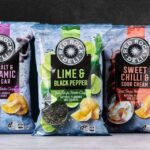Trans fats are associated with various lifestyle diseases. Trans fats are unhealthy fats, which are formed in healthy vegetable oils during processing or found naturally explains Shruti Sethi, Bindvi Arora, and Swarjyalaxmi Nayak.
Table of Contents
Fatty acids are characterized as either saturated or unsaturated based on the presence of double bonds in their structure. In the absence of double bonds, the fatty acid is said to be saturated; otherwise, it is unsaturated to some degree. The mono and polyunsaturated fatty acids present in unprocessed vegetable oils have double bonds, all in the normal “cis” configuration. In this configuration, the chains of carbon atoms are on the same side of the double bond, resulting in a kink whereas, in the trans configuration, hydrogen atoms are on the opposite side of the double bond of the carbon chain, making the fat molecule straight (Fig 1).
The melting point of the fats rich in CIS fatty acids is usually low because some CIS fats are liquid at room temperature. On the other hand trans fats usually have high melting points and are solid at room temperature. While some natural trans fats occur in meat and dairy products, the majority of trans fats are formed during processing such as hydrogenation. Hydrogenation is a chemical process that adds hydrogen atoms to the available double bonds in the vegetable oil. As the degree of hydrogenation increases, the amount of saturated fats increases, and mono and polyunsaturated fats decrease. Completely hydrogenated fat is solid. Natural trans fat found in rumen of animals include conjugated linoleic acid (CLA) and vaccenic acid. CLA contains both cis and trans double bonds. In other words, CLA is technically a trans-fat, but it is a natural type of trans fat that is found in many healthy foods.

Numerous studies (Mozaffarian 2009; Gebauer et al. 2016) show that industrial trans fats that are formed during processing are harmful, while trans fats found naturally in animal foods are not. These double bonds can easily be broken down by oxygen and can make the oil rancid (oxidation). Rancidity leads to the development of off-favors in foods. To control this, food manufacturers use hydrogenated vegetable oils. These are not as likely to break down as are not prone to oxidation and thus provides the product with a longer shelf life.
Hydrogenation
To treat with hydrogen – It is a chemical reaction between molecular hydrogen (H2) and another compound or element, usually in the presence of a catalyst. A typical hydrogenation reaction is depicted in Fig. 2. Since its development in the 1920s, edible oil hydrogenation has remained relatively unchanged. The edible oil industry has relied heavily on nickel (Ni) catalyst to manufacture partially hydrogenated vegetable oils. These catalysts offer several advantages, including high activity, tailored linoleic and linolenic selectivity, low cost, and ease of separation from the processed oil. Unfortunately, these catalysts also isomerize the naturally occurring cis double bonds of unsaturated fatty acids to the trans configuration.
The hydrogenation process consists of a series of reaction steps. When the fat molecule is adsorbed to the surface of Ni catalyst, the double bond (the point where the molecule is unsaturated) attaches with the active site on the catalyst. The activated fat molecule can then react with a hydrogen molecule adsorbed on the catalyst surface, eliminating the unsaturation. If no hydrogen is available, the double bond can reform and leave the catalyst surface. The double bonds of a fat molecule have an almost equal chance of reforming either in the CIS or the trans form. Thus approximately half of the molecules that contact the catalyst where hydrogen is not available will form trans fats.
Since trans fats are categorized as unhealthy, strategies to limit their formation are being searched upon. Principally, the strategies for reducing trans formation during hydrogenation include increasing the hydrogen pressure to increase the amount of hydrogen on the catalyst surface or using a less active catalyst with fewer active sites, so as to ensure that the catalyst surface always has enough absorbed hydrogen near the active sites. This can be achieved by producing catalysts with smaller surface area and less activation, or by pre-poisoning the catalyst and blocking most of the active sites with a catalyst poison such as sulphur. Slowing the reaction down so as to allow more hydrogen movement to the catalyst surface before the fat molecule is released by the catalyst can also be done by decreasing the temperature of the reaction. A substantial increase in hydrogen pressure requires significant changes in equipment. Current reactors are operated at pressures less than 500 kPa, (5 atmosphere), while pressures of 5 MPa (50 atmosphere) may be required to provide sufficient hydrogen for significantly reducing trans formation. This alternative would require the replacement of the current hydrogenation reactors at a substantial cost. The other two alternatives significantly decrease the reaction rate and result in a substantial decrease in the productivity of the hydrogenation reactor.
Reputation of trans fats
Trans fats have been around for more than a century and initially got into our diets for economic reasons. But they really only permeated our food supply in a big way when the public health experts decided they were good for us. The synthesis of hydrogenated compounds originated in the 1890s when French chemist Paul Sabatier discovered that metal catalysts could be used for hydrogenation reactions. In 1901, German chemist Wilhelm Normann experimented with hydrogenation catalysts and successfully induced the hydrogenation of liquid fat, producing semisolid fat, which came to be known as trans-fat. Proctor & Gamble quickly recognized the potential of trans fats, buying the patent in 1911 to make Crisco shortening. The use of trans fats in food products got a big boost during World War II, when there were butter shortages and the use of solid margarine products (laced with trans fats) picked up. Trans fats improve the flavor and texture of foods. Trans fats have a longer shelf life than oils or animal fats. Trans fats maintain high temperatures for frying without burning as well as are solid at room temperature.
Before 1990, some researchers suspected that partially hydrogenated oils were “bad fats,” but it wasn’t until the 1990s that research began to prove it. The government of India agreed in 2002 with researchers for the first time on record: that there is likely no safe level of trans fat and that people should eat as little as possible. Amendment was made in the PFA Rules,
1955 for trans fats labeling as (a) The foods in which hydrogenated vegetable fats or bakery shortening is used shall declare on the label that “Hydrogenated vegetable fats or bakery shortening used-contains trans fats”, (b) A health claim of ‘trans-fat-free’ may be made where the trans fat is less than 0.2g per serving of food, (c) A claim ‘saturated fat-free’ may be made only where the saturated fat does not exceed 0.1g per 100g or 100ml of food. Denmark is the first country in 2003 to regulate trans fat on a national basis, putting a very small cap on the amount that food may contain.

Later in 2003, the (USFDA) passes a law requiring that trans fat be listed on the Nutrition Facts label on food products; food manufacturers were given three years to comply.
Health issues related to trans fats
The popularity of trans fats in the initial years due to their functional benefits, masked the health issues trans fats have imposed on society. The majority of the trans fats in the food are industrially produced and are typically found in foods made with partially hydrogenated oil, baked and fried foods. There is a significant and growing body of evidence linking trans fats to coronary heart disease indicating that trans fats may do even more harm than saturated fats. Metabolic studies show that trans fats increase blood levels of LDL (bad) cholesterol and decrease blood levels of HDL (good) cholesterol. Saturated fats are thought to be less damaging because they elevate both the “bad” and “good” types of cholesterol. Studies carried out by the National Institute of Nutrition (NIN) to evaluate the effects of TFA from Indian vanaspati in rats showed that both saturated fatty acids and TFA increased insulin resistance.
FSSAI and NIN (2009) carried out a risk analysis of trans fats in the Indian diet concluded that Not more than 10% (7% for those with cardiac problems) and 1% of total energy should be derived from saturated fat and TFA, respectively. According to current scientific research and WHO recommendations, if the risk of cardiovascular disease has to be kept at safe levels, it is important for population and individual health that TFAs should be removed from the food supply and should be replaced by cis unsaturated fats from vegetable oils rather than saturated fats from tropical oils and animal fats.
The World Health Assembly resolved in 2004 that elimination of TFA should be a key point for action by governments. WHO/FAO has recently completed an extensive review of the latest research on the links of TFA to CVDs and diabetes and recommended that all countries should take urgent regulatory steps to limit trans fats in their diet so that clear danger to heart health in vulnerable groups is avoided.
Trans fats are related to Coronary Heart Disease (CHD) as well as cancer. There is weak and inconsistent evidence for a relationship between trans FA and breast or colorectal cancer. Weight gain and obesity are also suspected to be induced by trans fats: The evidence for a relationship between trans FA intake on risk of obesity or increased weight gain is limited to an 8-year weight gain of approximately 0.5-1.0 kg for an increase of 1% energy from trans fats. Consumption of unphysiological levels of dietary trans FA (20% energy) has been reported to induce postprandial hyper-insulinemia in obese subjects with type 2 diabetes. Trans fats have also been shown to promote Alzheimer disease.
Trans Fat and India
There are growing concerns about the potential health effects of TFAs particularly those derived from vanaspati. In India, vanaspati, margarine, desi ghee, butter, etc. are sources of TFA.TFAs level in vanaspati depends on multiple factors and could be as high as 50-60% of total fat content. Studies carried out by the National Institute of Nutrition(NIN) to evaluate the effects of TFA from Indian vanaspati in rats showed that both saturated fatty acids and TFA increased insulin resistance.
FSSAI and NIN (2009) carried out a risk analysis of trans fats in the Indian diet concluded that not more than 10% (7% for those with cardiac problems) and 1% of total energy should be derived from saturated fat and TFA, respectively. TFAs should be removed from the food supply and should be replaced by cis unsaturated fats from vegetable oils. The implications of replacing high TFA partially hydrogenated oil by substitutes were also considered by FSSAI. FSSAI proposes a level of TFA in Vanaspati / PHVO, be fixed at 10% maximum and brought down to 5% in 3 years.
Trans fats and the World scenario
According to current scientific research and WHO recommendations, if the risk of cardiovascular disease has to be kept at safe levels, it is important for population and individual health that TFAs should be removed from the food supply and should be replaced by cis unsaturated fats from vegetable oils rather than saturated fats from tropical oils and animal fats. The World Health Assembly resolved in 2004 that elimination of TFA should be a key point for action by governments. WHO/FAO has recently completed an extensive review of the latest research on the links of TFA to CVDs and diabetes and recommended that all countries should take urgent regulatory steps to limit trans fats in their diet so that clear danger to heart health in vulnerable groups is avoided.
Recommended dietary intake level of fats
WHO has recommended that TFA intake as a percent of Energy should not exceed 1%. The total fat intake as a % of Energy should not be less than 15% and should not exceed 30%. The intake of Saturated Fat (SFA) as a % of Energy should not exceed 10% (7% for cardiac patients)
How to limit the trans fats
- Check the Nutrition Facts panel and choose foods lower in trans fat and cholesterol.
- Choose vegetable oils
- Replace saturated and trans fats in your diet with mono- and polyunsaturated fats.
- Consider fish. Most fish are lower in saturated fat than meat.
- Limit foods high in cholesterol such as liver, egg yolks and full-fat dairy products, like whole milk.
- When eating out, ask what kinds of oils are being used.
Research advancement to reduce trans fats
Researchers at the United States Department of Agriculture (USDA) have investigated whether hydrogenation can be achieved without the side effect of trans fat production. They varied the pressure under which the chemical reaction was conducted – applying 1400 kPa (200 psi) of pressure to soybean oil in a 2 liter vessel while heating it to between 140 °C and 170 °C. The standard 140 kPa (20 psi) process of hydrogenation produces a product of about 40% trans fatty acid by weight, compared to about 17% using the high-pressure method. Blended with unhydrogenated liquid soybean oil, the high-pressure-processed oil produced margarine containing 5 to 6% trans fat. The level of trans fat may also be altered by modification of the temperature and the length of time during hydrogenation.
Conclusion
Trans fats are unhealthy fats, which are formed in healthy vegetable oils during processing or found naturally. Trans fats are associated with various lifestyle diseases such as cancer, obesity, cardiovascular diseases, atherosclerosis and arteriosclerosis amongst others. Thus limiting the intake of trans fats is necessary and can be achieved by limiting dietary intake of baked, snack, and processed foods. Food processing industries can also contribute in lowering the intake of trans fats. They may avoid utilizing hydrogenated fats which are rich in trans fat in processed foods and choose liquid vegetable oils or soft margarine that contains little or no trans fats.
References
- http://www.cdc.gov/diabetes/prevention/pdf/postcurriculum_session2.pdf
- http://en.wikipedia.org/wiki/Trans_fat
- http://www.cdc.gov/nutrition/everyone/basics/fat/transfat.html
- http://www.fssai.gov.in/Portals/0/Regulation_of_TFA_.pdf
- Gebauer S.K., Chardigny J.M., Jakobsen M.U., Lamarche B., Lock A.L., Proctor S.D. and David J. (2016) Baer Effects of Ruminant trans Fatty Acids on Cardiovascular Disease and Cancer: A Comprehensive Review of Epidemiological, Clinical, and Mechanistic Studies Advances in Nutrition.
- Mozaffarian D., Arora W.C. and Willett. (2009).Health effects of trans-fatty acids: experimental and observational evidence. European Journal of Clinical Nutrition, 63, S5–S21; doi:10.1038/sj.ejcn.1602973.
‘Processed Food Industry’: The Voice of Food Processing Industry
Processed Food Industry (PFI) is a premier English-language monthly B2B publication (ISSN 09721649) headquartered in New Delhi, catering to the vibrant and ever-evolving food processing industry. While we don’t claim to be the largest or most widely read, our proud legacy of over 27 years—publishing continuously since 1997—has earned us the trust of industry professionals as a reliable source of insights and information.
If your goal is to tap into the booming Indian and South Asian markets to promote your equipment, technology, software, or consumables, PFI is your strategic partner. With our hybrid approach across print, web, and social media, we help you establish strong brand recognition rooted in market relevance. Backed by a team of top-tier technical writers, we’re ready to work closely with you and your customers to craft compelling content that drives results.
India and South Asia’s food industry is expanding rapidly, driven by efficiency and cutting-edge innovations. Don’t miss the opportunity to elevate your brand and engage with this dynamic market. Get our 2025 media kit to fine-tune your marketing strategy, increase your visibility, and convert potential customers into valuable conversations. Additionally, ask for a sample copy of our monthly magazine and experience the quality and relevance we deliver.
Let us help you define your role in the future of the food processing industry.

Have a news or topic to share with industry? Write to us editorial@pfionline.com
















